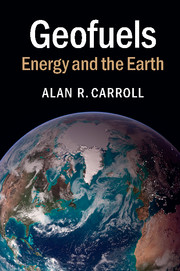Book contents
- Frontmatter
- Contents
- Acknowledgments
- 1 Introduction
- 2 The Living Earth
- 3 Warmed from Above: Solar Energy
- 4 Wind, Water, and Waves: Energy from the Fluid Earth
- 5 Covered in Green: Biofuels Basics
- 6 Fossil Farming: The Geologic Underpinnings of Biofuels
- 7 The Light of an Ancient Sun: Fossil Fuel Origins
- 8 Digging for Daylight: Coal and Oil Shale
- 9 Skimming the Cream: Conventional Oil and Gas
- 10 Stuck in the Mud: Fossil Fuels That Fail to Flow
- 11 Petrified Petroleum: Oil Sand and Gas Hydrate
- 12 Water, Water, Everywhere
- 13 Primordial Power: Geothermal and Nuclear
- 14 Out of Sight, Out of Mind: Geologic Waste Disposal
- 15 How Long Is Forever? Energy and Time
- 16 Conclusions
- Index
- References
15 - How Long Is Forever? Energy and Time
Published online by Cambridge University Press: 05 March 2015
- Frontmatter
- Contents
- Acknowledgments
- 1 Introduction
- 2 The Living Earth
- 3 Warmed from Above: Solar Energy
- 4 Wind, Water, and Waves: Energy from the Fluid Earth
- 5 Covered in Green: Biofuels Basics
- 6 Fossil Farming: The Geologic Underpinnings of Biofuels
- 7 The Light of an Ancient Sun: Fossil Fuel Origins
- 8 Digging for Daylight: Coal and Oil Shale
- 9 Skimming the Cream: Conventional Oil and Gas
- 10 Stuck in the Mud: Fossil Fuels That Fail to Flow
- 11 Petrified Petroleum: Oil Sand and Gas Hydrate
- 12 Water, Water, Everywhere
- 13 Primordial Power: Geothermal and Nuclear
- 14 Out of Sight, Out of Mind: Geologic Waste Disposal
- 15 How Long Is Forever? Energy and Time
- 16 Conclusions
- Index
- References
Summary
Prediction is very difficult, especially about the future.
Commonly attributed to Niels BohrPicture a herd of woolly mammoths grazing amid grass-covered, rolling hills on an autumn morning. They are moving slowly along a river that is muddy with silt, derived from melting of the last remnants of a glacial ice sheet that once covered half the continent. There is a chill in the air, with a strong breeze blowing in from the northwest. A group of fur-clad hunters stalks the mammoths from the opposite direction, discussing details of their attack plan with hand signals and low guttural grunts. If the hunt is successful they may survive through the long winter ahead; otherwise their future is in doubt.
Although incredibly primitive by modern standards, this scene could actually have played out as recently as ten thousand years ago, hardly a blink of the eye in geological terms. Agriculture began to spread through the eastern Mediterranean region only about two thousand years afterward, and the earliest pyramids in Egypt were built at the approximate midpoint in time between the disappearance of woolly mammoths and the appearance of cell phones.
The historical details have been lost to the ages, but it seems clear that massive environmental change, brought on by a respite in continental glaciation, set the stage for early human civilization. If Stone Age and earlier humans had any thoughts at all about the future of energy, they would almost certainly have been along the lines of “How can I keep warmer?” The idea that global warming might eventually become a problem would have been utterly unimaginable.
Since that time, the cutting edge of technology has advanced from stone axes to lasers, and our dominant energy sources have evolved from human muscle to fossil fuels. The historically recent emergence of the latter has transformed the world at unprecedented rates, leading many to worry about how long we can maintain the standard of living that we have come to accept as our birthright.
- Type
- Chapter
- Information
- GeofuelsEnergy and the Earth, pp. 314 - 341Publisher: Cambridge University PressPrint publication year: 2015



